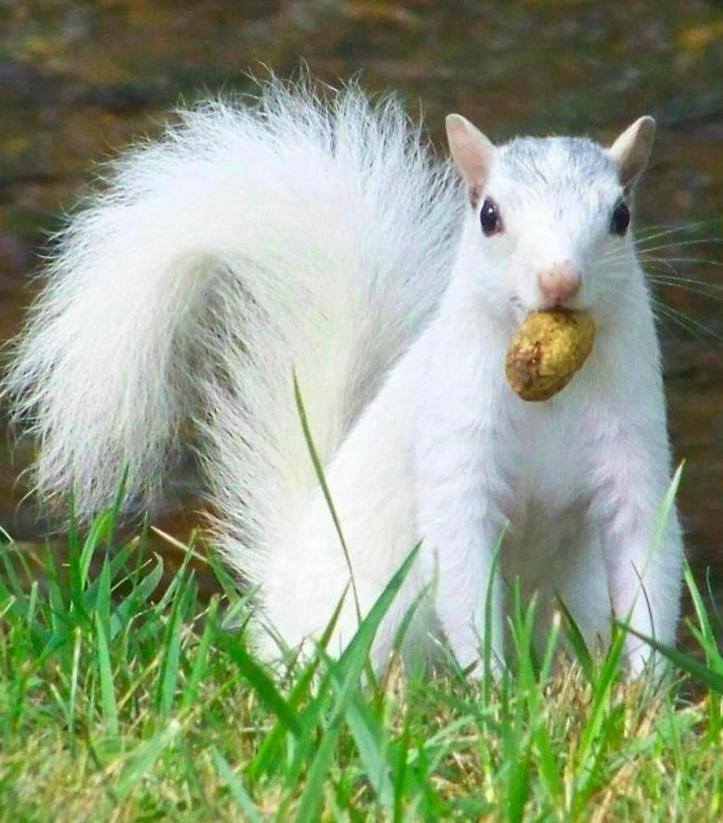Squirrel white is a term that evokes curiosity and fascination for many wildlife enthusiasts and animal lovers alike. The unique beauty of white squirrels, which are quite rare, has captured the attention of people across North America and beyond. These charming creatures, with their striking fur, stand out against the backdrop of green trees and colorful landscapes, making them a delightful sight to behold. Their presence often stirs questions about genetics, habitat, and conservation efforts, as well as a longing to learn more about these enchanting animals.
As we delve deeper into the world of squirrel white, we will explore the various aspects that contribute to their allure. From their distinct appearance to the myths and legends that surround white squirrels, there is much to uncover. Moreover, understanding their behavior and habitat can help us appreciate the significance of these creatures in our ecosystems. With increasing sightings of white squirrels in urban and rural settings, it’s essential to discuss their conservation and the impact of human activities on their populations.
In this article, we will answer several questions regarding squirrel white, including their origins, the science behind their color, and how we can support their conservation. Whether you are a casual observer or a dedicated wildlife enthusiast, the world of white squirrels holds many surprises and insights that can broaden your understanding of these remarkable animals.
What Are White Squirrels?
White squirrels are a variant of the Eastern gray squirrel, and their striking white fur is caused by a genetic mutation. While they are often mistaken for albino squirrels, white squirrels typically have pigment in their eyes, giving them a more natural appearance than true albinos. This unique coloration makes them stand out in their natural habitats, which can be both a blessing and a curse.
Where Do White Squirrels Live?
White squirrels can be found in various regions across North America, particularly in areas where gray squirrels are prevalent. They thrive in urban and suburban settings, where they can take advantage of food sources provided by humans. Some towns have even embraced their white squirrel populations, incorporating them into local culture and tourism.
What Causes the White Coloration in Squirrels?
The white coloration in squirrels results from a genetic mutation affecting melanin production. This mutation can lead to varying degrees of white fur, and in some cases, white squirrels may have patches of gray or brown fur. Factors such as inbreeding and environmental conditions can also play a role in the prevalence of white squirrels in certain areas.
Are White Squirrels Rare?
White squirrels are relatively rare compared to their gray counterparts, with estimates suggesting that only 1 in 100,000 squirrels may exhibit the white coloration. This rarity contributes to their allure and makes spotting one a memorable experience for many nature enthusiasts.
What Myths Surround White Squirrels?
Throughout history, white squirrels have been the subject of various myths and folklore. Some cultures view them as symbols of good luck or omens of prosperity. In certain towns, white squirrels are celebrated through festivals and events, reinforcing their status as local legends. These stories contribute to the fascination surrounding these animals and highlight the cultural impact they can have.
How Can We Support White Squirrel Conservation?
To support the conservation of white squirrels, it’s essential to promote awareness and understanding of their habitats and behaviors. Here are some ways to help:
- Educate the public about the importance of preserving natural habitats.
- Participate in local conservation efforts and wildlife monitoring programs.
- Report sightings of white squirrels to local wildlife organizations.
- Encourage responsible feeding practices to avoid dependency on human food sources.
Can White Squirrels Adapt to Urban Environments?
Yes, white squirrels can adapt to urban environments, just like their gray counterparts. The availability of food sources and shelter in cities encourages them to thrive in these settings. However, urban living poses challenges, such as increased traffic and habitat fragmentation, which can impact their populations.
What Role Do White Squirrels Play in Their Ecosystems?
White squirrels, like other squirrels, play a crucial role in their ecosystems. They are essential seed dispersers, helping to propagate various tree species. Their foraging habits contribute to plant diversity and overall ecosystem health. Additionally, they serve as prey for various predators, maintaining the balance of the food web.
Are White Squirrels Protected by Law?
In most areas, white squirrels are not specifically protected by law, but they are often covered under general wildlife protection regulations. Local ordinances may vary, so it’s important to check with local wildlife authorities for specific regulations regarding white squirrels in your area.
Conclusion: The Enchantment of Squirrel White
In conclusion, the allure of squirrel white extends beyond their stunning appearance. Understanding their biology, the myths surrounding them, and their ecological significance can deepen our appreciation for these fascinating creatures. By promoting conservation efforts and fostering awareness, we can ensure that future generations will have the opportunity to marvel at the beauty of white squirrels in their natural habitats.
Exploring The Life And Legacy Of Donovan Leitch Jr.
Understanding Red Eagle Politics: A Deep Dive Into Its Influence
Discovering The Essence Of Shona Joy: Fashion, Passion, And Creativity


